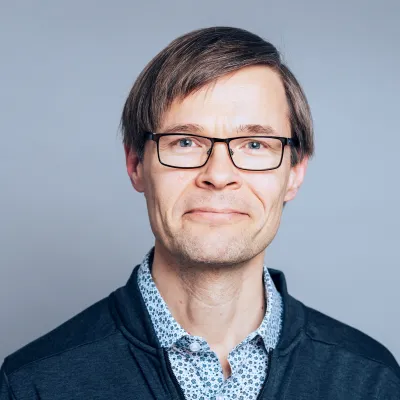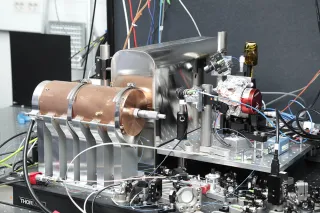One of the world’s most accurate optical atomic clocks is ticking at the VTT MIKES laboratory in Espoo. The device indicates that the most accurate unit of measure in the International System of Units (SI), the second, requires redefinition. The Finnish national metrology institute, VTT MIKES, will be presenting the topic in more detail at an event celebrating the 150th anniversary of the Metre Convention.
Read the summary
- The advancement in optical atomic clocks is enabled by technological breakthroughs such as the optical frequency comb and stable laser sources with narrow linewidths.
- Finland's most precise time-keeping work is conducted at VTT's Otaniemi laboratory, using a device that cools and measures strontium atoms to extremely low temperatures, promising applications in future time definitions.
This summary is written by AI and checked by a human.
Seventeen countries signed the Metre Convention on 20 May 1875. Each year, the World Metrology Day is celebrated on this date to commemorate the signing of the Convention. Because 150 years have passed since the advent of the SI system, the celebration will be more extensive than usual. The MIKES metrology unit at VTT will also hold an all-day event for experts at Otaniemi on 15 May.
Redefinition of the second will be one of the topics discussed at the event. The redefinition of time also affects other basic units of measure: For example, according to its definition, the metre is the distance travelled by light in a vacuum in billionths of a second, or in other words around 300 000 kilometers a second
"The duration of the SI second is not changing, but its precise definition requires updating. This is due to new, more accurate optical atomic clocks, which we also have here at VTT. Except for the mole, all other units in the SI system rely on the definition of a second,” says Martti Heinonen, Vice President of VTT MIKES.
New second 100 times more accurate than today
Optical atomic clocks are the result of several technological breakthroughs in the 21st century.
“The optical frequency comb, which received the Nobel Prize in Physics in 2005, enables easy and virtually error-free measurement of optical frequencies. Now we also know how to make extremely stable laser sources with a linewith of less than 1 Hertz. This enables us to build atomic clocks based on a so-called optical transition that are 100 times more accurate than devices based on the microwave transition of a caesium atom,” explains Anders Wallin, Senior Scientist at VTT MIKES.
The best cesium atomic clocks realize the SI second with an accuracy of about 16 decimal places, while after the redefinition, optical atomic clocks will realize the second with an accuracy of 18 decimal places. This means that the error of an optical atomic clock is a few picoseconds per month.
Since 1967, the definition of a second has been based on a caesium atomic clock. Prior to that, astronomical definitions were used. The definition based on an optical atomic clock is expected to enter into effect in 2034. The decision-making body of the member states meets once every four years, and the process, including amendments, takes time.
“In the future, there will be a set of clocks that includes both optical and microwave-based atomic clocks,” says Heinonen.
Finland’s most accurate work with strontium atoms and lasers
A laser-cooled optical atomic clock developed by VTT is being used in redefinition of the second. It is located in the VTT MIKES time laboratory at Otaniemi in Espoo. A device with a table-top area of two square metres traps a single strontium atom and measures its resonant frequency. The atom remains stationary by an electric field and cooled (slowed down) by lasers until its speed corresponds to a temperature that is one thousandth of a degree Celsius above absolute zero.
“We started work on building a new atomic clock in 2011. Since in 2020, we’ve been running experiments with the device and conducted frequency comparisons with satellites. We can easily say that, here at Otaniemi, we are doing the most accurate work in Finland,” Wallin says.
Previously, conventional atomic clocks were purchased from abroad every 10 to 20 years. However, optical clocks required for the new level of accuracy are not commercially available, which made it necessary to build a device from scratch.
VTT MIKES experts expect its own optical atomic clock to be used in keeping the Coordinated Universal Time (UTC). VTT has long used caesium atomic clocks that provide a commercially continuous time service. Like the best cesium clocks, optical clocks do not run continuously but are used to calibrate the time produced by commercial, continuous-time clocks.
The new atomic clock at the VTT MIKES laboratory is kept inside strong magnetic shielding. The need for shielding is increased by the fact that the nearby metro line causes fluctuations in the magnetic field. A comparison of the accuracy of the device has been made using satellite GNSS frequency links and a portable atomic clock from Germany that is based on an ytterbium atom.
A laser-cooled optical atomic clock developed by VTT is being used in redefinition of the second. It is located in the VTT MIKES time laboratory at Otaniemi in Espoo. A device with a table-top area of two square metres traps a single strontium atom and measures its resonant frequency. The atom remains stationary by an electric field and cooled (slowed down) by lasers until its speed corresponds to a temperature that is one thousandth of a degree Celsius above absolute zero.

MEDIA MATERIAL










